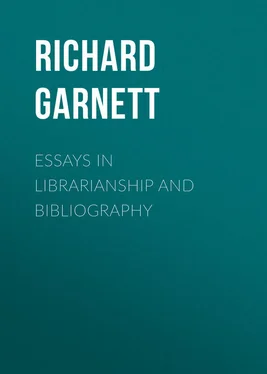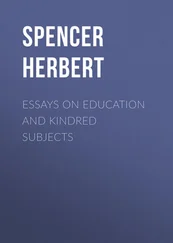Richard Garnett - Essays in Librarianship and Bibliography
Здесь есть возможность читать онлайн «Richard Garnett - Essays in Librarianship and Bibliography» — ознакомительный отрывок электронной книги совершенно бесплатно, а после прочтения отрывка купить полную версию. В некоторых случаях можно слушать аудио, скачать через торрент в формате fb2 и присутствует краткое содержание. Жанр: foreign_antique, foreign_prose, на английском языке. Описание произведения, (предисловие) а так же отзывы посетителей доступны на портале библиотеки ЛибКат.
- Название:Essays in Librarianship and Bibliography
- Автор:
- Жанр:
- Год:неизвестен
- ISBN:нет данных
- Рейтинг книги:4 / 5. Голосов: 1
-
Избранное:Добавить в избранное
- Отзывы:
-
Ваша оценка:
- 80
- 1
- 2
- 3
- 4
- 5
Essays in Librarianship and Bibliography: краткое содержание, описание и аннотация
Предлагаем к чтению аннотацию, описание, краткое содержание или предисловие (зависит от того, что написал сам автор книги «Essays in Librarianship and Bibliography»). Если вы не нашли необходимую информацию о книге — напишите в комментариях, мы постараемся отыскать её.
Essays in Librarianship and Bibliography — читать онлайн ознакомительный отрывок
Ниже представлен текст книги, разбитый по страницам. Система сохранения места последней прочитанной страницы, позволяет с удобством читать онлайн бесплатно книгу «Essays in Librarianship and Bibliography», без необходимости каждый раз заново искать на чём Вы остановились. Поставьте закладку, и сможете в любой момент перейти на страницу, на которой закончили чтение.
Интервал:
Закладка:
We must hold, then, that the alphabetical index of subjects should be the auxiliary and complement of the Alphabetical Catalogue, not a part of it; that each book should be entered in it, as in the catalogue, once and once only; that the minor indexes should be grouped together so as to form collectively a whole ( e. g. ornithology and ichthyology, as sub-sections of zoology); and that the operations of cataloguing and indexing should go on pari passu . If this is attended to for the future, the future will take care of itself; but "not Heaven itself upon the past has power," and it is discouraging to think upon the immense leeway which remains to be made up in most of our great public libraries. The experience of the Bodleian will be very valuable, and we must confess to much curiosity to see how long the operation of classifying its multifarious contents will take. In the British Museum the foundation of a classed catalogue has already been laid by a simple process. As fast as the titles have been transcribed for insertion in the three copies of the catalogue by a manifold writer, a fourth copy has been taken, and this copy is arranged in the order of the books on the shelves. As the various subjects are kept together in the library, such an arrangement is practically equivalent to a rough classed catalogue, which could be digested into order with comparative facility. The publication of such a classified index, reduced to the utmost possible brevity, offers, as it seems to us, the best solution of the vexed question of the publication of the Museum Catalogue. On this point much remains to be said. Meanwhile, before quitting the subject of cataloguing methods, a tribute is due to Mr. Cutter's important contribution to the subject, in his rules for his Dictionary Catalogue. Next after the settlement of the Museum rules in 1839, these form the most important epoch in the history of cataloguing. Agreeing with the latter rules in the main, and when differing, generally, as we must think, not differing for the better, they nevertheless contain a most valuable body of acute reasoning and apt illustration, which it did not fall within the province of the Museum authorities to provide; they bring unusual experience and ability to bear upon the intricate subject of classification, and are further reinforced by most ingenious remarks on the economy and manipulation of print, making the mere variations of type instructive.
Assuming the catalogue to be completed, the question remains for decision whether it shall be printed. In most cases this question is easily determined with reference to the circumstances of the individual library; but in one instance the nation claims a voice in the matter. It is hardly necessary to say that we refer to the Catalogue of the British Museum, the theme of forty years' controversy. Every one will admit the intrinsic superiority of a catalogue in print over a catalogue in MS. The question is, whether the advantage may not be bought too dear. To form a sound opinion on this point it is necessary to have an approximate estimate of the extent of the Museum Catalogue, and of the expenditure and the time involved in the undertaking to print it. Some statistics may accordingly be useful. The printed volume of the catalogue containing letter A, published in 1841, has about 20,000 entries. It forms about a twentieth part of the catalogue as it now exists, which would accordingly comprise about 2,000,000 entries, in about 100 folio volumes. In addition, however, to these titles now existing in the catalogue, there are about 200,000 titles and cross-references awaiting final revision, and which, unless the present state of this revision is very considerably accelerated, will not be ready for several years. During all this period, titles for new acquisitions will keep pouring in at the rate of 40,000 per annum. All the time that the catalogue is at press, somewhere between a decade and a generation, they will continue to pour in, and will have to be included as far as possible. We must consequently expect to have to deal with from 3,000,000 to 4,000,000 titles, occupying from 150 to 200 volumes folio. It is clear that no private individual could afford either to purchase or to store such a catalogue. It would, therefore, only be useful to such institutions as might buy it or receive it as a gift. Unlike the newspapers we have mentioned, its usefulness would diminish in the ratio of its antiquity, and it could only be kept up to the mark by a succession of supplements. The total cost of providing it, minus these supplements, may be roughly estimated at £100,000. We scarcely think that Government will incur such an expenditure for such a purpose.
We should ourselves have little hesitation in pronouncing it undesirable to print the Museum Catalogue as it stands, merely for the convenience of the public. It is quite another question whether a recourse to print may not be desirable in the interests of the Museum itself, and from this point of view the answer must be widely different. It is desirable, and will shortly become imperative. The reason is prosaic, but unanswerable: the MS. catalogue cannot be much longer accommodated in the Reading Room. Partly from necessity, partly from oversights, the Museum Catalogue is most extravagant in the matter of space. To preserve the alphabetical order of the entries, the titles are necessarily movable, pasted, therefore, on each side of the catalogue leaf, thus trebling the thickness of the latter. It is equally indispensable that wide spaces should be left between the entries when a volume is first laid down, and that when these become insufficient from the number of additions, as is continually happening, the over-charged volume should be divided into three or four. These inconveniences are unavoidable. It can only be regretted that part of the available space of every slip is lost in transcription; that scarcely a single transcriber appears to have studied the art of packing; and that the catalogue is over-run with practically duplicate entries of slightly differing editions, transcribed at full length while they might have been expressed in a single line. From all these causes the Museum Catalogue is rapidly becoming unmanageable, and the time is approaching when the Reading Room will contain it no longer. Something might no doubt be done to postpone the evil day by excluding the map and music catalogues from the room; but apart from its inconvenience, such a measure is obviously a mere temporary palliative and ultimate aggravation of a difficulty which acquires strength not eundo , but by standing still. The bulk of the catalogue must be reduced, and we are not aware that any method has been suggested, or exists, except a recourse to print. It is unfortunate that this purely administrative measure, founded on no preference for print over manuscript as such, but the simple dictate of an economic necessity, should be so constantly confounded with the totally different proposition to print and publish the catalogue like any other book, on the expense and inutility of which we have already commented. Publication is not in question: it is simply for the authorities to consider whether the bulk of the MS. catalogue will not some day shut out the public from access to it; and if this is found to be the case to lose no time in averting the evil. We do not believe that the present Principal Librarian, or his predecessor, entertains any doubt upon the subject; the ultimate decision, however, rests neither with the Principal Librarian nor the Trustees, but with the Treasury. From the Treasury's point of view, it is to be observed that the present system is financially justifiable only on condition of its being persisted in to the end of time. If a resort to print will one day be compulsory, existing arrangements are the climax of inconsiderate wastefulness. That transcribing is cheaper than printing may be admitted, though it has hardly been demonstrated. But to print is manifestly cheaper than to print and transcribe also. Yet this is just what the Museum is doing if the catalogue is ever to be printed at all. There are about 250,000 titles for the new catalogue still remaining to be transcribed. To transcribe these at the present rate of progression would occupy about fifteen years, but let us say ten. During this period titles for new acquisitions would be coming in at the rate of 40,000 a year. These would also be transcribed. The total number of transcripts would thus be 650,000. Now it seems to be seriously contemplated by the advocates of a complete printed catalogue that all this enormous mass of careful copy shall in a few years be completely superseded by print, and rendered absolutely useless. After paying, let us say, threepence a slip to do its work, the nation is to pay fourpence a slip more to undo it, and is to be charged altogether twice as much as it need have been if it had known what it wanted from the first. It is, indeed, high time for the representatives of the nation in these matters to determine once and for ever whether the catalogue is to be in print or manuscript. If MS., let the idea of print be authoritatively discountenanced; but if print, let the ruinous system be abandoned of paying highly for work performed only to be undone.
Читать дальшеИнтервал:
Закладка:
Похожие книги на «Essays in Librarianship and Bibliography»
Представляем Вашему вниманию похожие книги на «Essays in Librarianship and Bibliography» списком для выбора. Мы отобрали схожую по названию и смыслу литературу в надежде предоставить читателям больше вариантов отыскать новые, интересные, ещё непрочитанные произведения.
Обсуждение, отзывы о книге «Essays in Librarianship and Bibliography» и просто собственные мнения читателей. Оставьте ваши комментарии, напишите, что Вы думаете о произведении, его смысле или главных героях. Укажите что конкретно понравилось, а что нет, и почему Вы так считаете.












